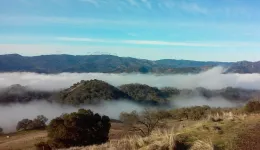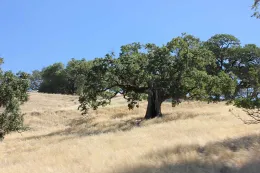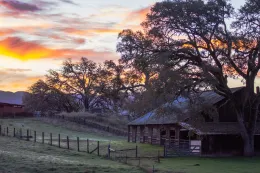
As one of nine Research and Extension Centers operated by the UC Division of Agriculture and Natural Resources, this location is administratively separate from the UC campuses. Many researchers who use the Center hold faculty appointments at UC Davis or UC Berkeley or are UC Cooperative Extension advisors located in California counties.
Our History
In 1951, the University purchased the 4,630-acre Roy L. Pratt Ranch in Hopland, California to use as a site for long-term, controlled research on native rangelands, watersheds, and wildlife. Adjacent higher-elevation acreage was later acquired from the federal government. The Center now encompasses 5,358 acres of land with a deep history.

Our Landscape and Research Environment
Four principal vegetation types (grass, woodland-grass, dense woodland, and chaparral) are found here, including more than 600 plant species. Most of the acreage is rangeland of rugged topography, situated in the foothills of the Mayacamas Mountains, part of the Coast Range. Only about 25 acres of valley floor are irrigated and suitable for cropland. Riparian corridors are found throughout the Center in drainages from natural springs, and along Parson's Creek, a tributary of the nearby Russian River. Also on the Center are several natural ponds, as well as many seasonal vernal pools. The Center provides a rich, diversified opportunity for natural resources and agricultural research and extension programs, especially on topics pertinent to rangelands of the central and northern coast of California.
Research Programs and Techniques
Historically, the Center's educational mission has focused on animal science, rangeland management, wildlife, plant science, entomology, and public health. Techniques developed at HREC for managing North Coast rangelands by the introduction of subterranean clover and fertilization with essential nutrients have significantly increased forage productivity and quality. Other research has included plant response to grazing, fire, and other management strategies. The role of native hardwoods, especially oaks, has received recent attention, with emphasis on sustainable management of valley oak (Quercus lobata) and blue oak (Quercus douglasii) stands. Plantings of wine grapes and pears provided opportunities for closely monitored variety trials, studies of plant productivity, and development of strategies for controlling insect pests and plant diseases.

Educational Mission
HREC also hosts field trips, workshops, tours, and hands-on learning opportunities for undergraduate and graduate students from UC campuses and elsewhere.
